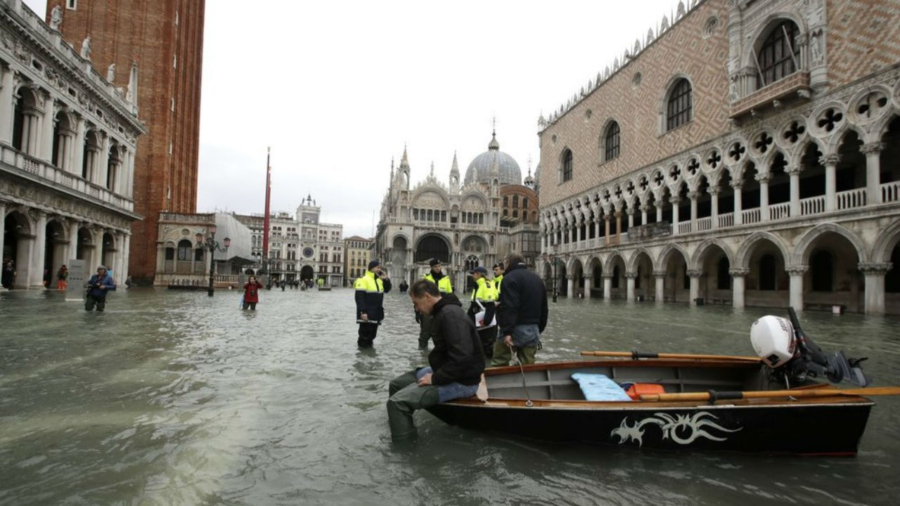VENICE, Italy—Venice was hit Sunday by a record third exceptional tide in the same week while other parts of Italy struggled with a series of weather woes, from rain-swollen rivers to high winds to an out-of-season avalanche.
Stores and museums in Venice were mostly closed in the hardest-hit area around St. Mark’s Square, but tourists donned high rubber boots or even hip waders to witness and photograph the spectacle.
Most were disappointed when officials closed the historic square as winds rippled across the rising waters. The doors of the famed St. Mark’s Basilica were securely shut to the public, and authorities took precautions—stacking sandbags in canal-side windows—to prevent salt water from entering the crypt again.
Venice’s Tide Office said the peak tide of nearly 5 feet hit just after 1 p.m. but a weather front off the coast blocked southerly winds from the Adriatic Sea from pushing the tide to the predicted level of 5 feet, 2 inches. By early evening, the level was less than three feet.

Still it marked the third time since Tuesday night’s 6 feet 1 inch-high floodwaters—the worst in 53 years—that water levels in Venice had topped just shy of 5 feet. Since records began in 1872, that level had never been reached even twice in one year, let alone three times in one week.
While Venetians had a bit of relief, days of heavy rainfall and snowfall elsewhere in Italy swelled rivers to worrisome levels, triggering an avalanche in the Alps and saw dramatic rescues of people unable to flee rising waters.
In Venice, many store owners in the swanky area around St. Mark’s completely emptied their shops, while others put their wares as high as possible and counted on automatic pumping systems to keep the water at bay. In one luxury boutique, employees used water vacuums and big squeegee mops to keep the brackish lagoon waters from advancing.

Venice’s mayor has put the flooding damage at hundreds of millions of euros and Italian officials have declared a state of emergency for the area.
Luca D’Acunto and his girlfriend Giovanna Maglietta surveyed the rising water from a bridge, wondering how to reach their nearby hotel in their colorful yet inadequate rubber boots.
“We made the reservation this week before the floods and had paid already, so we came,” said D’Acunto, a 28-year-old from Naples. “Instead of a romantic trip, we’ll have an adventurous one.”
Most museums were closed as a precaution, but the Correr Museum, which overlooks St. Mark’s Square and explores the art and history of Venice, remained open. Tourists enjoyed a Venetian Spritz—a colorful aperitif with an Italian bitter and Prosecco—as the waters rose.

Officials said 280 civil protection volunteers were deployed to assist as needed. Young Venetian volunteers in rubber boots have also showed up at key sites, including the city’s Music Conservatory, to help save precious manuscripts from the invading salt water.
The flooding has raised renewed debates about the city’s Moses flood defense project, a corruption-riddled underwater barrier system that is still not operational after more than 16 years of construction and at least 5 billion euros (€5.5 billion) of public funding. It was supposed to be working by 2011.
Floods were also hitting other parts of Italy on Sunday.
In Pisa, famed for its Leaning Tower, workers sandbagged the road along the rising Arno River, which authorities said had reached the highest level there and in another Tuscan city, Florence, since 1992.
“I ask citizens to go home and stay there,’’ Pisa Mayor Michele Conti, said in an appeal on state TV. He said bridges were being closed as a precaution in case the Arno overran its banks. Pisa’s offices and stores were ordered shuttered until midday Monday.
The Arno also surged through the heart of historic Florence, reaching a level near the Uffizi Galleries that was described as the highest in some 20 years. In 24 hours, 2.5 inches of rain had fallen in Florence, which was whipped by winds as high as 42 mph per hour.

A popular Florence tourist attraction, the Boboli Gardens, was closed as a precaution for fear of falling trees. Near the Tuscan town of Cecina, 500 people were evacuated when a local river swelled to the top of its banks.
Elsewhere in Tuscany, 2,000 people were ordered evacuated in Grosseto as the Ombrone river swelled dangerously. Near Grosseto, firefighters rescued a man clinging to a tree as floodwaters surrounded him.
In the countryside outside of Bologna, in the central-north Emilia Romagna region, an elderly couple was plucked to safety by a helicopter when the Idice river overran its banks.
In Italy’s mountainous Alto Adige, or South Tyrol region, a mid-autumn snowstorm triggered power outages and blocked roads in several Alpine valleys. The mayor of Val Martello, Georg Altstaetter, told state TV that an avalanche had damaged two houses but caused no injuries. Other homes were evacuated as a precaution in the town, which was left without electricity.
The region’s governor told people to stay home so crews could clear snow-clogged roads.
A windstorm overnight in the Rome area toppled scores of trees, with two falling on cars, severely injuring a motorist.
Some politicians lamented that the drama over Venice’s high tides was eclipsing the needs of other areas.
In Matera, a once-impoverished southern town that has experienced a renaissance through tourism, heavy rain sent torrents of mud racing through its streets last week, ruining shops and lodging.
“There are no minor-league regions,” said Luigi Di Maio, a populist who leads the 5-Star Movement, the government’s main party.
By Colleen Barry and Luca Bruno


